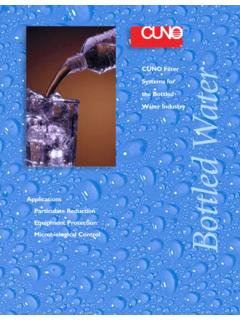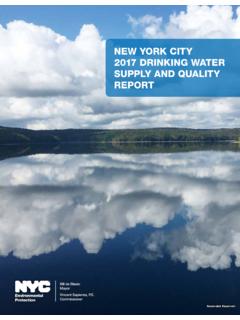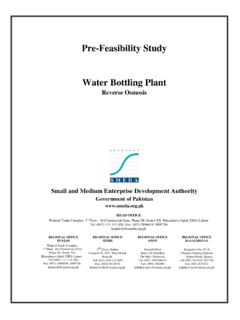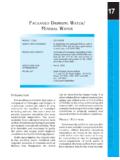Transcription of BIOGAS PURIFICATION, COMPRESSION AND BOTTLING
1 , (6):34-38 (November-December, 2013) ISSN: 2319 7293 34 BIOGAS purification , COMPRESSION AND BOTTLING Ramesh Babu Nallamothu1, Abyot Teferra2, & Prof Appa Rao3 1 Research Scholar, Marine Engineering Department, College of Engineering, Andhra University, Visakhapatnam, India. (Associate Professor, SOE, ASTU, Adama). 2 MSc student, SOE, ASTU, Adama. 3 Professor, Marine Engineering Department, College of Engineering, Andhra University, Visakhapatnam, India. Abstract In the present scenario of dwindling petroleum resources and global warming, exploring other avenues for eco-friendly fuels became essential.
2 BIOGAS which is a clean and environmental friendly fuel emerged as one of the potential alternative fuels. Raw BIOGAS contains about 60-70% methane (CH4), 30-40% carbon dioxide (CO2), traces of hydrogen sulfide (H2S) and fractions of water vapours. But its wide spread use is hampered by the associated problems like low energy density due to the presence of impurities, generation at low pressures and the absence of means for storing and transporting. In this context this work intends to design and establish a facility at the site of BIOGAS production in the campus for purifying, compressing, BOTTLING and making it transportable.
3 This can be done by compressing the gas in cylinders which was possible only after removing its CO2, H2S and water vapour components. To increase the energy density of the gas, different experiments were conducted in removing incombustible and corrosive gas. To remove this impurities steel wool, water and silica gel was used. The steel wool is to react with the hydrogen sulphide, the water is to reduce the percentage of carbon dioxide and the silica gel is to reduce the presence of water vapour in the purified BIOGAS . Experiment showed that, the methane concentration available in the raw and purified BIOGAS was 68 % and 90 % respectively.
4 COMPRESSION of purified BIOGAS was carried out by using a hermetic reciprocating type refrigerant compressor and bottled into normal LPG cylinder. COMPRESSION of BIOGAS was carried out up to an absolute pressure of 5 bars in total of 12-14 minutes. In order to evaluate the impact of BIOGAS purification on heating value, purified and raw BIOGAS was used to heat 500 ml of water and took and minutes respectively. Keywords: BIOGAS , purification , COMPRESSION , BOTTLING . 1. Introduction BIOGAS is generated when bacteria degrade biological material in the absence of oxygen; in a process known as anaerobic digestion.
5 Since BIOGAS is a mixture of methane (CH4), carbon dioxide (CO2), hydrogen sulphide and traces of water vapour. It is a renewable fuel produced from waste treatment. Anaerobic digestion is basically a simple process carried out in a number of steps by many different bacteria that can use almost any organic material as a substrate - it occurs in digestive systems, marshes, rubbish dumps, septic tanks and the Arctic Tundra. BIOGAS is a gas produced from organic materials such as animal manure, human excreta, kitchen remains, crops straws and leaves after decomposition and fermentation under air tight ( no oxygen ) condition.
6 Main products of the anaerobic digestion are BIOGAS and slurry. After extraction of BIOGAS (energy), the slurry comes out of the digester as a by-product of the anaerobic digestion system. The main constituents of BIOGAS are the CH4 and CO2 gas. The BIOGAS burns very well when the CH4 content is more than 50% and therefore BIOGAS can be used as a substitute for kerosene, charcoal and fire wood for cooking and lighting. This saves time and money and above all it conserves the natural resources from cutting trees to get firewood, as shown in table 1. Table 1: Composition of BIOGAS .
7 Source: (Ayoub 2002) In the above table, we can see that the combustible components of BIOGAS are CH4 and H2. Other gases are useless, toxic or harmful and have no energy contribution in BIOGAS . Also, among these two gases only CH4 is present in a significant amount and hence, is considered in most cases involving BIOGAS . In Ethiopia, major application of BIOGAS has only been in cooking and lighting. Commonly the gas produced in the digester is transported to desired place say kitchen by pipe line, on the pressure developed in the BIOGAS digester dome itself.
8 But this is not sufficient to transport gas to farther distances from the generation site. This is why, uses of BIOGAS are hindered. Moreover, due to its limited use BIOGAS until now is not produced at a persuasive amount. A large scale BIOGAS plant producing a large amount of BIOGAS is Substances Symbol Percentage Methane CH4 50-70 % Carbon dioxide CO2 30-40 % Hydrogen H2 5-10 % Nitrogen N2 1-2 % Water Vapour H2O % Hydrogen Sulphide H2S traces , (6):34-38 (November-December, 2013) ISSN: 2319 7293 35 often rendered and valueless due to the lack of its effective and efficient use.
9 Due to this lack of portability of BIOGAS there have been no efforts what so ever to commercialize the use of BIOGAS . Production of BIOGAS could be a continuous process. The utilization of BIOGAS as an efficient energy source depends strongly on its methane concentration. Therefore, BIOGAS purification is essential in order to have more energy per unit volume of compressed BIOGAS and to get rid of the corrosive effect of H2S. This can be done by compressing the gas into the cylinders, which is possible only after removing carbon dioxide (CO2), hydrogen sulfide (H2S) and water vapour.
10 BIOGAS purification increases the concentration of methane in BIOGAS , in order to have fuel of higher calorific value. This can be achieved by decreasing the concentration of carbon dioxide. Elimination of carbon dioxide from the BIOGAS helps to increase its calorific value as well as to eliminate the greenhouse gas. 2. Materials and Methods The procedures followed in this experiment involves: Designing and establishing of BIOGAS purification , COMPRESSION and BOTTLING unit and Executing different tests, namely - amount of carbon dioxide in the BIOGAS test, water acidity test and water boiling test.












